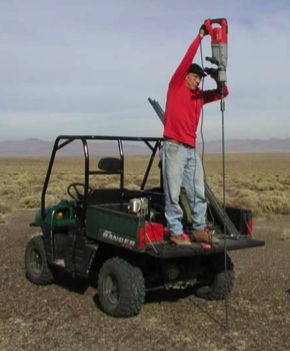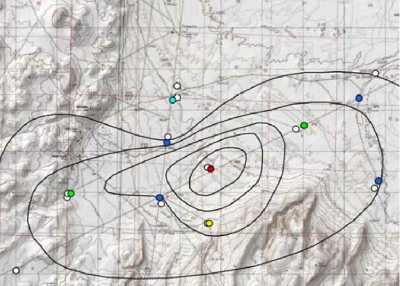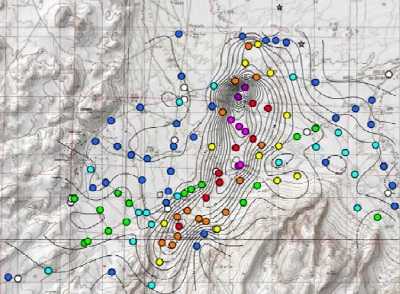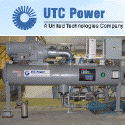Archive for the 'Geothermal' Category
Deep sea geothermal?
Ormat Technologies (ORA) was granted an 11,000 acre geothermal lease off the coast of Texas. This is significant in it represents the first such lease in Texas, home of petroleum.
One has to wonder about the feasibility of tapping into such a resource in that area. By all indications it is a DEEP resource we’re talking about that will be technically difficult to tap – think ocean drilling rig expensive. We’ll watch development of this resource with interest. Thanks to Jim for passing this along yesterday.
If you liked this entry, Digg It!
Technorati Tags: Energy | Geothermal | Texas
DoE’s Geothermal Research Program not funded FY2007
In what has become one of the latest examples of the Bush Administration’s difficulty with matching their actions to their words, the geothermal program at the Department of Energy will receive funding this fiscal year of $0 if the budget passes as is. This is a national tragedy in the making as we are unable (or unwilling) to make use of all the assets we have to drive toward energy independence.
Why is geothermal important? I’m glad you asked. Geothermal power is the only renewable capable of baseload generation – meaning, it’ll be there when you flip your TV on (you do expect it to come on, right?) Solar, wind, biomass, and hydro are all less than baseload as they are affected by external factors (sunlight, wind, and drought.) Geothermal power generation in a closed system is zero emission. In an open system, it’s still far less than 1% as polluting as coal generation. The recent MIT study demonstrated there is more than enough heat stored in the Earth’s crust for us to harvest to power the nation (and indeed, the world.) You would think that a power source with these attributes would be at or near the top of any energy policy’s priorities.
When one considers the size of the Department of Energy’s proposed budget, the ridiculousness of this action becomes clear: The total budget is $24,300,000,000 or $24.3 BILLION. The size of the geothermal program? $0.0022B or $22 MILLION. The amount budgeted for maintaining our nuclear capability? $9.4 billion. The amount set aside to clean up the environmental messes we’ve already made? $9.4 billion. The amount budgeted for basic science? $4.4 billion (this is a good thing, but geothermal must be part of the research program.) $3.1 billion is budgeted for energy efficiency and supply programs. Fundamentally, I have nothing against other renewable programs being funded (an aside, solar funding is flat, wind has been cut 10%, hydro and geothermal have been cut altogether; hydrogen, biomass, and “clean coal” have all seen big increases in funding.) But I do have heartburn with failing to fund the one renewable electricity generation source that stands a chance of displacing aging, dirty coal plants.
The geothermal program is a rounding error in a budget of this size. The program deserves to be funded an order of magnitude more per year in order to realize the potential of the geothermal resources inside our border, not eliminated. The solution to this budget mess is clear, cut “clean coal” research by $250 million and use it to fund geothermal at the right level. After all, if coal pollution is cut by anything less than 99%, it’s still more polluting than the dirtiest geothermal resource. This is a matter of priorities and, as usual, the Bush Administration is confused in what is in the national interest by why is in the interest of their big money donors (see TXU and the $11 BILLION dollar coal construction binge in Texas.) Politics clearly play a role in this as well as Harry Reid (D,) US Senator from Nevada (home to huge amounts of geothermal potential) is the Senate Majority Leader, the Administration is aiming to hurt him at home and/or use that as a lever to get something else in the future if they cave on the geothermal research request.
In the end, it doesn’t really matter why this is happening. The action signals the end of US government support for geothermal as a renewable energy source. A resource that could over the course of 50 years displace the entire coal electricity generation infrastructure in the United States with the attendant environmental benefits. And that’s the point, isn’t it? Geothermal is being sacrificed on the altar of “clean coal” – if ever there was an oxymoron, it is “clean coal.”
We’ll watch closely to see what changes happen in the proposed budget, but we’re not hopeful. If you would like make yourself heard on the subject, write your local Congressial representative and your Senators.
If you liked this entry, Digg It!
Technorati Tags: DoE | FY07 Budget | Geothermal Slashed
Enormous Geothermal Canal Proposed
Well here is a bold and interesting idea: Dig a long canal >128km (>80 miles) about 15 meters in diameter (~50 feet) at a depth of >5km (>3 miles) from the ocean on the Atlantic coast inland. Why? Because temperatures exceed 150C (~300F) at that depth, there is no shortage of ocean water, and the transfer of heat to that water over such a long distance would be sufficient to power a geothermal “Hoover Dam” equivalent on the eastern seaboard.
Clearly a project of this magnitude is neither easy nor cheap, but J. David Reynolds at Atlantic Geothermal is championing just such an approach. Aside from the obvious practical challenges of such a project, there are some other things like the amount of total dissolved solids in the water that would definitely need to be addressed. For instance, in the Salton Sea geothermal area in California, one must use titanium lined pipes to withstand the corrosive nature of the geothermal resource. That’s not cheap.
Nevertheless, this is a bold idea who’s feasibility will be debated hotly, no doubt. Regardless of your position on feasibility, it’s nice to see someone thinking big and sustainable.
If you liked this entry, Digg It!
Technorati Tags: Large Scale Geothermal | Northeast | Atlantic Geothermal
Finding geothermal resources
If you wondered why there weren’t more geothermal projects, you’re not alone. One of the more vexing things about geothermal resources is finding them. When compared with other renewable resources it’s a much more challenging endeavour. After all, it’s pretty evident how to determine if a site is appropriate for wind or solar generation by monitoring the wind speed and sunlight in potential site areas. While there is definitely science involved, a layperson can do a pretty good job in suggesting sites.
Geothermal, not so much. There are some obvious signs that a geothermal system is at work, these include volcanos, faults, geysers, hotsprings, fumaroles, travertine deposits, and tufa towers. But none of these indications necessarily mean that an area is productive, just clues that they might be productive. So, how does one “discover” and then qualify a geothermal resource?
The answer is that aside from obvious vulcanism and spewing hot water on the surface, to date, most areas are discovered as an unwanted side effect of another activity, like mining or drilling for petroleum. In other words, geothermal finds tend to be the result of serendipidous accidents or stunningly obvious features observed on the surface. The majority of geothermal resources however are called “blind” resources – that is, there is little if any indication on the surface of the earth that a particular spot might house a geothermal resource. Which begs the question: how does one go about specifically looking for geothermal resources and then qualifying them? Particularly “blind” resources (as most of the obvious surface indicated resources have been tapped or protected – like Yellowstone Park’s geysers.)
At the Stanford Geothermal conference yesterday, there were several approaches to find “blind” geothermal resources presented. Most of these have been around for awhile that are increasingly useful in indicating where one might choose to invest serious money to drill a test well. For those who aren’t familiar with the drilling industry, these holes cost a few million dollars to drill. Thus, you want to be pretty sure you’re in an area that will produce before breaking ground.
Of the approaches including thermal imaging, gravity measurements, magnetic resonance, electrical resistance, and shallow temperature prospecting, the shallow temperature approach seems to be the best tool from my perspective. Effectively, this is a method of drilling 2 meter holes in a grid, measuring the temperature at depth, and factoring the surface trends to get a data set. Mark Coolbaugh presented this talk yesterday of a test he performed in the Desert Peak area in Nevada. The results were impressive and interesting as this is a known geothermal production area – even potentially uncovering further resource in the Desert Queen area.
The way it works is dead simple. A grid is laid out over an interesting area, at periodic intervals (every x meters for instance) a 2 meter deep hole is created with a special, hollow steel drill bit attached to an electric hammer drill. It takes a few minutes to drive this into the ground. Once secured, a temperature probe is dropped down the center of the bit and after an hour passes or so, the temperature is taken. The hour was derived by testing to see how quickly a hole returned to base temp state after digging. Instead of having a few measurements available over a large area with huge costs – even 60M “slim holes” for temperature gradient are expensive – one gets a large number of measurements over the same area.
Driving bit into the ground

Desert Queen – 9 Temperature Gradient Wells with 2m temps overlayed. Note, the whites are the temperature gradient wells, the blues are “cold” and the yellows, oranges, and reds are “hot.” As you can see, there is an assumption made about the resource size and shape with the contour lines.

Desert Queen – All 2m data points (and temperature gradient wells.) As you can see, the 9 data point model badly misconstrued the size and shape of the potential resource. The contour lines are 1 degree C differences and at 2m the delta T between “background” and “hot” was greater than 20 degrees C.

This particular approach does have limitations in that shallow aquifers or wet ground will impede the accuracy of the method, but considering the vast majority of geothermically active area in the US is located in arid climates, this isn’t such a barrier to use. Of course, the most effective way (and only way) to truly qualify a resource is through drilling and flow testing of the geothermal resource. At present, drill rig rental runs around $22,500 per DAY – without the crew and that’s if you can even find a rig to rent. It’s an expensive undertaking to be sure. But a simple, relatively cheap, and relatively fast way to profile a large area is using this shallow temperature approach. It seems to work and should be a valuable tool in the geothermal prospector’s portfolio.
The summary is that there are many methods to find “blind” resource and we’re constantly getting better at it. Another question is, who is actually looking for such resources? The only answer I can provide at present is virtually no one.
If you liked this entry, Digg It!
Technorati Tags: Discovery | Blind | Geothermal
Just how much geothermal potential is in the US?
This is a question bandied about frequently in geothermal circles. Recently, a panel chaired by Jeff Tester from MIT set out to answer that question and they presented their results at the 32nd Stanford Geothermal Conference yesterday.
Let’s first setup the measurement system, it’s in exa-joules (EJ.) A kilowatt hour is approximately 3.6M joules. An exa-joule is 10 to 18th power joules, or 1,000,000,000,000,000,000 joules. The entire US electric consumption for a year is around 100 EJ. Now that this is a nice easy way to think of it, 1 EJ = 1% of annual US electricity consumption, I’ll tell you what they discovered.
That if only 2% of the US geothermal potential was tapped, we would be able to access some 28,000 EJ in electric power generation. This statement is grand and requires some explanation. There are two flavors of geothermal power, hydrothermal and enhanced or engineered geothermal systems. This combines the output of both methods and predicts that resources at deep as 10km will be exploited over the next 50 years.
Even if this estimate is wrong by two orders of magnitude, it’s still 28x our current annual electricity consumption for the entire country. That is sufficient to cause even the most jaded person to stop and think. What could we achieve if we diligently work to tap and harvest this resource inside our own borders, with no carbon emission, and maintain our energy system with baseload power? What’s the impact of simply displacing old coal plants with new geothermal plants?
The study goes on to say that they believe 100,000 MWe (generation capacity) is entirely feasible by 2050, which is only 10% of the current electricity consumption per year in the US. There’s now a nice article posted on the MIT website that references this study available here.
I’ve said it before and I’ll say it again, each megawatt hour of electricity generated by burning coal yields a ton of carbon and 14 kg of SOx and NOx into the atmosphere. To produce a new “clean” coal plant is a $1B+ investment. Fuel cost of coal has increased 35% over the past 6 years. Our ability to transport new coal in the US is constrained by railroad capacity, which is at capacity. Why invest in coal now?
Why not invest in clean power generation where the fuel is free and local. Nothing gets vented into the atmosphere (in a closed system) and start solving our dependence and climate impact. This isn’t rocket science….
If you liked this entry, Digg It!
Technorati Tags: Geothermal | Potential | EGS








